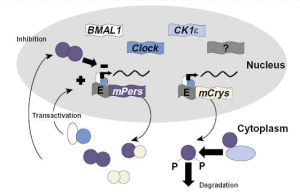 Gianne Derks and Anne Skeldon have been awarded MILES funding to work on “Mathematical modelling of circadian processes“. The project is joint with Dr Simon Archer from the Department of Biochemistry and Physiology and Prof Derk-Jan Dijk from the Surrey Sleep Research Centre. A short description of the project follows.
Gianne Derks and Anne Skeldon have been awarded MILES funding to work on “Mathematical modelling of circadian processes“. The project is joint with Dr Simon Archer from the Department of Biochemistry and Physiology and Prof Derk-Jan Dijk from the Surrey Sleep Research Centre. A short description of the project follows.
The primary components that form the clock in mammals are relatively well understood but internal resonance and how the core clock mechanism relates to circadian-regulated processes is a challenging and important question. It has been established that the circadian clock is composed of an auto-regulatory transcriptional network with interlocked feedback loops involving the transcriptional activators such as BMAL1, CLOCK and NPAS2 that activate the Per1, Per2, Cry1 and Cry2 genes. While the core clock is believed to consist of just a few components, many thousands of transcripts have been shown to express circadian oscillations. Very little is known about the overall architecture of the interactions between the core circadian process and the biorhythms they drive. For example, how is it that different transcripts peak at a wide range of different points in the day when they all driven by the same core circadian clock?
In this project gene transcription data that has been collected under different conditions will be fitted to a model of the circadian clock. Understanding the dynamics of the circadian model and the way that parameters in the model need to change in order to mimic the different experimental conditions will lead to insight into what underlying biological processes are affected in the different scenarios.
